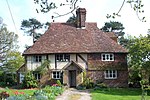St. Mary the Virgin, Chiddingstone
Diocese of RochesterGrade II* listed churches in KentKent building and structure stubs

St. Mary the Virgin is a parish church in the united benefice of Chiddingstone, Penshurst, Chiddingstone Causeway and Fordcombe in the episcopal Diocese of Rochester. It is a Grade II* listed building with Historic England.
Excerpt from the Wikipedia article St. Mary the Virgin, Chiddingstone (License: CC BY-SA 3.0, Authors, Images).St. Mary the Virgin, Chiddingstone
Chiddingstone Road,
Geographical coordinates (GPS) Address External links Nearby Places Show on map
Geographical coordinates (GPS)
| Latitude | Longitude |
|---|---|
| N 51.1863 ° | E 0.1462 ° |
Address
St Mary The Virgin Chiddingstone
Chiddingstone Road
TN8 7AG
England, United Kingdom
Open on Google Maps










